Can’t work out what that bird is? Scroll through and have a look at some of our photos to see if it helps. If you are still unsure or just want some help with the survey, please contact the group on Facebook, or ask one of the Survey Buddies.
Click on the image to bring up a bigger picture and some notes about the bird. As the seasons change, we’ll be adding more birds to this list so do come back again!
House Sparrows, Dunnocks and Reed BuntingsAlthough from different families, these can look similar if you don’t always get a good view of them. Sparrows and Dunnocks are very common visitors all year whereas the Reed Bunting is an unusual winter visitor to a few gardens that border open countryside
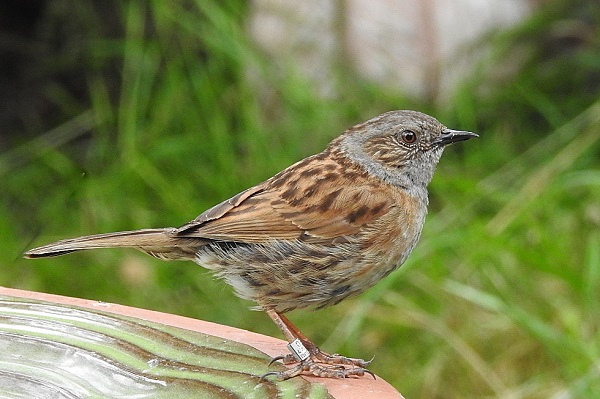
Dunnock

Female House Sparrow
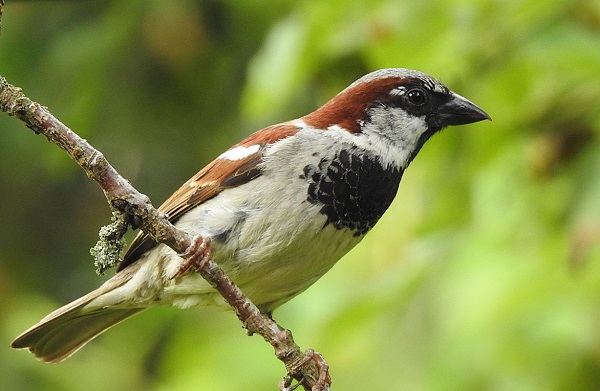
Male House Sparrow

Female Reed Bunting
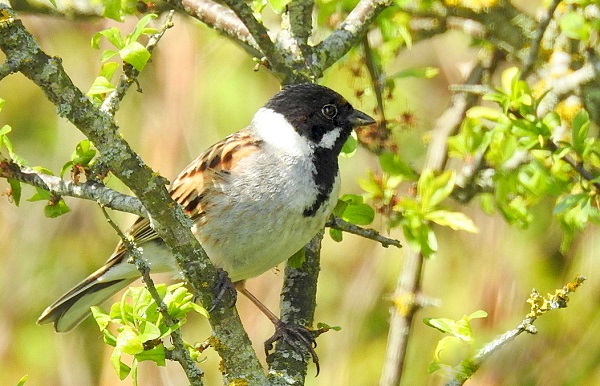
Male Reed Bunting
-

Dunnock
Dunnock
Despite its old name of Hedge Sparrow, this belongs to a completely different family and behaves in a different way. Dunnocks go about their life trying to be inconspicuous, feeding under hedges and trees and also picking up spilled seeds from under the feeders.
-

Female House Sparrow
Female House Sparrow
Female House Sparrows can look like female Chaffinches but the beak is thicker and hasn’t got the noticeable white streaks in the wing.
-

Male House Sparrow
Male House Sparrow
A very familiar but declining species, once you start looking closely at them, you will see that they come in all sorts of shades and plumage patterns! Adult males can have a black patch on its breast and the one with the biggest black patch in a colony is the alpha male of the group.
Select View More to see a video about them, courtesy of Avibirds.com
-

Female Reed Bunting
Female Reed Bunting
Has similar plumage and markings to House Sparrows but slimmer in appearance and has a longer tail with white along the edges of the tail.
-

Male Reed Bunting by Paula Blake
Male Reed Bunting
Has similar plumage and markings to House Sparrows but slimmer in appearance and has a longer tail with white along the edges of the tail. When the male moults into its summer plumage, the black head of the male is unmistakeable.
TitsThere are 4 types of tits that are regularly reported in gardens, with Blue and Great Tits being the most common, all these species can be seen all year

Great Tit

Blue Tit

Long Tailed Tit

Coal Tit
-

Great Tit
Great Tit
Slightly bigger than a Blue Tit and the black head and white face patch separates it from a Blue Tit. Also active at feeders and if you get a good view, you can tell the males and females apart, the stripe down the breast is much thicker on the male.
Select View More to see a video about them, courtesy of Avibirds.com
-

Blue Tit
Blue Tit
Small, brightly coloured, very active on feeders, used to be called blue caps in Victorian times. After breeding and during winter they form feeding parties and mix with other species. You can tell young Blue Tits as their faces are yellow instead of white.
Select View More to see a video about them, courtesy of Avibirds.com
-

Long Tailed Tit
Long Tailed Tit
Very distinctive and unmistakeable, the only species that visits your garden feeders with a long tail. You can often hear their soft ‘purring’ before you see them as a feeding party approaches, which in the middle of winter can be quite large.
-

Coal Tit
Coal Tit
Smallest of the tits, usually seen on its own and is definitely at the bottom of the ‘pecking’ order at the feeders when it darts in when the other species aren’t looking! It has a distinctive white stripe through the black cap on the head.
ThrushesWe have 2 regular resident species of thrush that can be seen in gardens, Blackbird and Song Thrush while in winter they can sometimes be visited by ‘invaders’ from the north, Fieldfare and Redwing. Very occasionally, if your garden borders fields or open countryside, a Mistle Thrush might put in an appearance. All are a similar size and like to feed on the ground, but in winter thrive on berries in our gardens.

Female Blackbird

Male Blackbird

Fieldfare

Redwing

Song Thrush

Mistle Thrush

Robin
-

Female Blackbird
Female Blackbird
Female Blackbirds are browner than males, some have a distinctly speckled breast and can sometimes be mistaken for a Song Thrush.
-

Male Blackbird
Male Blackbird
Males are unmistakable, all black with a yellow beak.
-

Fieldfare
Fieldfare
Like Redwings, Fieldfare come to gardens in midwinter searching out berries and fruit. It’s grey head and rufous brown back distinguishes it from the other thrushes, though it does have spots on the front.
-

Redwing
Redwing
Very similar to Song Thrush, often comes to your garden in small flocks whereas Song Thrushes are generally on their own. Look out for a noticeable stripe over the eye and, in good light, you can see the red flush on the side.
-

Song Thrush
Song Thrush
Dark brown on top with heavy spotting on the breast, turns over vegetation on the ground looking for grubs, especially snails.
-

Mistle Thrush
Mistle Thrush
The largest of the thrushes, it is similar to a Song Thrush but is greyer than brown on the back and the spots on the front are bolder. They tend to prefer feeding out in the open whereas song thrushes are more often found feeding under vegetation.
-

Robin
Robin
The Robin is actually in the thrush and chat family so has been included here, but as it’s the nation’s favourite bird, everyone recognises it, although young robins have a speckled chest before they grow out their red breast.
FinchesA colourful group of small birds, most of which regularly visit garden feeders, particularly in winter. If you get a good view you can usually identify them though some of the females can look similar to each other.

Female Chaffinch
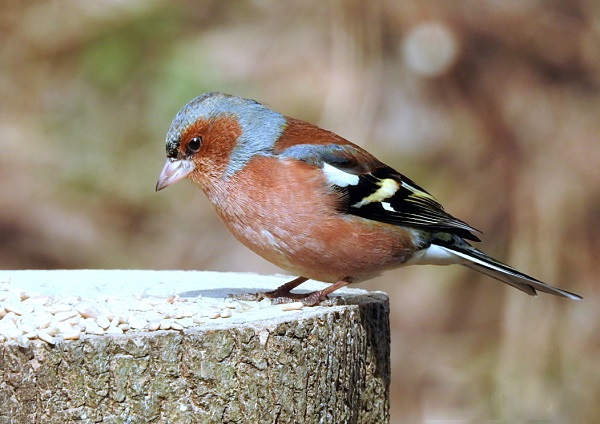
Male Chaffinch

Goldfinch

Bullfinch

Greenfinch

Female Siskin

Male Siskin
-

Female Chaffinch
Female Chaffinch
The female has similar markings to the male with all the colours washed out and can look very much like a female House Sparrow, but the white wing bars do still stand out.
-

Male Chaffinch
Male Chaffinch
A common visitor to gardens, the colourful male is pretty easy to identify.
Select View More to see a video about them, courtesy of Avibirds.com
-

Goldfinch
Goldfinch
Brightly coloured with bright yellow flashes in the wing and red faces makes this unmistakeable, though in the late summer when the young come to the feeders, they are much less colourful, lacking the red face.
-

Bullfinch
Bullfinch
A beautiful bird that is increasingly visiting more gardens, not always easy to see, despite its bright scarlet red breast as it tends to stay deeper within the vegetation, but every now and again it sits prominently out on a branch.
-

Greenfinch
Greenfinch
The bright green male with the yellow stripe in the wing is very striking while the female is similar looking but with a lot of the colour washed out. Sadly, this species is very vulnerable to trichomonosis, a parasite that they pick up from dirty garden feeders.
-

Female Siskin
Female Siskin
Another green finch but smaller than a Greenfinch, the male has black on the head and is much more streaked in appearance. It is an occasional winter visitor from the north, not always making it this far south every year
-

Male Siskin
Male Siskin
Another green finch but smaller than a Greenfinch, the male has black on the head and is much more streaked in appearance. It is an occasional winter visitor from the north, not always making it this far south every year.
Pigeons and DovesThere are three very familiar visitors to gardens, Woodpigeon, Collared Dove and Feral Pigeon, all distinctive as the pictures show.

Stock Dove

Feral Pigeon

Wood Pigeon

Collared Dove
-

Stock Dove
Stock Dove
It can be quite difficult to sort out Stock Doves from Feral Pigeons, less so Woodpigeons. They are smaller than Woodpigeons and lack the white patches around the back of the neck. They are an overall blue grey colour with green iridescent band at the back of the neck and pinkish breast. They have two partial black bands at the back of the wings. You can separate from a Feral Pigeon by the lack of a pale rump.
-

Feral Pigeon
Feral Pigeon
-

Woodpigeon
Wood Pigeon
-

Collared Dove
Collared Dove
WoodpeckersThere are 2 Woodpeckers that might visit your garden, both very striking and both very different from each other.

Great Spotted Woodpecker

Green Woodpecker
-

Great Spotted Woodpecker
Great Spotted Woodpecker
Unmistakable, the Great Spotted Woodpecker is a regular visitor to garden feeders and in the summer, they actually bring their chicks to feeding stations to show them food sources.
-

Green Woodpecker
Green Woodpecker
The only large green bird with a long dagger like beak and is likely to be probing with that beak into your lawn particularly looking for ants.
Crows Four species of crows are regular garden visitors throughout the year, but it has to be said that they are not always universally popular!

Magpie

Jay

Carrion Crow

Jackdaw
-

Magpie
Magpie
Magpies are very distinctive and once seen and can be easily identified, it is bold and is often attracted to feeders.
-

Jay
Jay
Jays tend to stay in trees and are much more of a woodland species than the Magpie, preferring not to stay out in the open.
-

Carrion Crow
Carrion Crow
Carrion crows are just black with a big beak and mostly seen singly or sometimes there can be a couple of them.
-

Jackdaw
Jackdaw
The jackdaw is smaller than the Crow and has a grey head. Given the chance, they like to nest in chimneys.
House Sparrows, Dunnocks and Reed Buntings
Although from different families, these can look similar if you don’t always get a good view of them. Sparrows and Dunnocks are very common visitors all year whereas the Reed Bunting is an unusual winter visitor to a few gardens that border open countryside






Dunnock

Female House Sparrow

Male House Sparrow

Female Reed Bunting

Male Reed Bunting
-

Dunnock
Dunnock
Despite its old name of Hedge Sparrow, this belongs to a completely different family and behaves in a different way. Dunnocks go about their life trying to be inconspicuous, feeding under hedges and trees and also picking up spilled seeds from under the feeders. -

Female House Sparrow
Female House Sparrow
Female House Sparrows can look like female Chaffinches but the beak is thicker and hasn’t got the noticeable white streaks in the wing. -

Male House Sparrow
Male House Sparrow
A very familiar but declining species, once you start looking closely at them, you will see that they come in all sorts of shades and plumage patterns! Adult males can have a black patch on its breast and the one with the biggest black patch in a colony is the alpha male of the group. Select View More to see a video about them, courtesy of Avibirds.com -

Female Reed Bunting
Female Reed Bunting
Has similar plumage and markings to House Sparrows but slimmer in appearance and has a longer tail with white along the edges of the tail. -

Male Reed Bunting by Paula Blake
Male Reed Bunting
Has similar plumage and markings to House Sparrows but slimmer in appearance and has a longer tail with white along the edges of the tail. When the male moults into its summer plumage, the black head of the male is unmistakeable.
Tits
There are 4 types of tits that are regularly reported in gardens, with Blue and Great Tits being the most common, all these species can be seen all year





Great Tit

Blue Tit

Long Tailed Tit

Coal Tit
-

Great Tit
Great Tit
Slightly bigger than a Blue Tit and the black head and white face patch separates it from a Blue Tit. Also active at feeders and if you get a good view, you can tell the males and females apart, the stripe down the breast is much thicker on the male. Select View More to see a video about them, courtesy of Avibirds.com -

Blue Tit
Blue Tit
Small, brightly coloured, very active on feeders, used to be called blue caps in Victorian times. After breeding and during winter they form feeding parties and mix with other species. You can tell young Blue Tits as their faces are yellow instead of white. Select View More to see a video about them, courtesy of Avibirds.com -

Long Tailed Tit
Long Tailed Tit
Very distinctive and unmistakeable, the only species that visits your garden feeders with a long tail. You can often hear their soft ‘purring’ before you see them as a feeding party approaches, which in the middle of winter can be quite large. -

Coal Tit
Coal Tit
Smallest of the tits, usually seen on its own and is definitely at the bottom of the ‘pecking’ order at the feeders when it darts in when the other species aren’t looking! It has a distinctive white stripe through the black cap on the head.
Thrushes
We have 2 regular resident species of thrush that can be seen in gardens, Blackbird and Song Thrush while in winter they can sometimes be visited by ‘invaders’ from the north, Fieldfare and Redwing. Very occasionally, if your garden borders fields or open countryside, a Mistle Thrush might put in an appearance. All are a similar size and like to feed on the ground, but in winter thrive on berries in our gardens.








Female Blackbird

Male Blackbird

Fieldfare

Redwing

Song Thrush

Mistle Thrush

Robin
-

Female Blackbird
Female Blackbird
Female Blackbirds are browner than males, some have a distinctly speckled breast and can sometimes be mistaken for a Song Thrush. -

Male Blackbird
Male Blackbird
Males are unmistakable, all black with a yellow beak. -

Fieldfare
Fieldfare
Like Redwings, Fieldfare come to gardens in midwinter searching out berries and fruit. It’s grey head and rufous brown back distinguishes it from the other thrushes, though it does have spots on the front. -

Redwing
Redwing
Very similar to Song Thrush, often comes to your garden in small flocks whereas Song Thrushes are generally on their own. Look out for a noticeable stripe over the eye and, in good light, you can see the red flush on the side. -

Song Thrush
Song Thrush
Dark brown on top with heavy spotting on the breast, turns over vegetation on the ground looking for grubs, especially snails. -

Mistle Thrush
Mistle Thrush
The largest of the thrushes, it is similar to a Song Thrush but is greyer than brown on the back and the spots on the front are bolder. They tend to prefer feeding out in the open whereas song thrushes are more often found feeding under vegetation. -

Robin
Robin
The Robin is actually in the thrush and chat family so has been included here, but as it’s the nation’s favourite bird, everyone recognises it, although young robins have a speckled chest before they grow out their red breast.
Finches
A colourful group of small birds, most of which regularly visit garden feeders, particularly in winter. If you get a good view you can usually identify them though some of the females can look similar to each other.








Female Chaffinch

Male Chaffinch

Goldfinch

Bullfinch

Greenfinch

Female Siskin

Male Siskin
-

Female Chaffinch
Female Chaffinch
The female has similar markings to the male with all the colours washed out and can look very much like a female House Sparrow, but the white wing bars do still stand out. -

Male Chaffinch
Male Chaffinch
A common visitor to gardens, the colourful male is pretty easy to identify. Select View More to see a video about them, courtesy of Avibirds.com -

Goldfinch
Goldfinch
Brightly coloured with bright yellow flashes in the wing and red faces makes this unmistakeable, though in the late summer when the young come to the feeders, they are much less colourful, lacking the red face. -

Bullfinch
Bullfinch
A beautiful bird that is increasingly visiting more gardens, not always easy to see, despite its bright scarlet red breast as it tends to stay deeper within the vegetation, but every now and again it sits prominently out on a branch. -

Greenfinch
Greenfinch
The bright green male with the yellow stripe in the wing is very striking while the female is similar looking but with a lot of the colour washed out. Sadly, this species is very vulnerable to trichomonosis, a parasite that they pick up from dirty garden feeders. -

Female Siskin
Female Siskin
Another green finch but smaller than a Greenfinch, the male has black on the head and is much more streaked in appearance. It is an occasional winter visitor from the north, not always making it this far south every year -

Male Siskin
Male Siskin
Another green finch but smaller than a Greenfinch, the male has black on the head and is much more streaked in appearance. It is an occasional winter visitor from the north, not always making it this far south every year.
Pigeons and Doves
There are three very familiar visitors to gardens, Woodpigeon, Collared Dove and Feral Pigeon, all distinctive as the pictures show.





Stock Dove

Feral Pigeon

Wood Pigeon

Collared Dove
-

Stock Dove
Stock Dove
It can be quite difficult to sort out Stock Doves from Feral Pigeons, less so Woodpigeons. They are smaller than Woodpigeons and lack the white patches around the back of the neck. They are an overall blue grey colour with green iridescent band at the back of the neck and pinkish breast. They have two partial black bands at the back of the wings. You can separate from a Feral Pigeon by the lack of a pale rump. -

Feral Pigeon
Feral Pigeon
-

Woodpigeon
Wood Pigeon
-

Collared Dove
Collared Dove
Woodpeckers
There are 2 Woodpeckers that might visit your garden, both very striking and both very different from each other.



Great Spotted Woodpecker

Green Woodpecker
-

Great Spotted Woodpecker
Great Spotted Woodpecker
Unmistakable, the Great Spotted Woodpecker is a regular visitor to garden feeders and in the summer, they actually bring their chicks to feeding stations to show them food sources. -

Green Woodpecker
Green Woodpecker
The only large green bird with a long dagger like beak and is likely to be probing with that beak into your lawn particularly looking for ants.
Crows
Four species of crows are regular garden visitors throughout the year, but it has to be said that they are not always universally popular!





Magpie

Jay

Carrion Crow

Jackdaw
-

Magpie
Magpie
Magpies are very distinctive and once seen and can be easily identified, it is bold and is often attracted to feeders. -

Jay
Jay
Jays tend to stay in trees and are much more of a woodland species than the Magpie, preferring not to stay out in the open. -

Carrion Crow
Carrion Crow
Carrion crows are just black with a big beak and mostly seen singly or sometimes there can be a couple of them. -

Jackdaw
Jackdaw
The jackdaw is smaller than the Crow and has a grey head. Given the chance, they like to nest in chimneys.
Gulls Some species of gulls are just as much at home inland as they are on the coast, so throughout the year gulls may be seen around the village and in some gardens. The two species you are most likely to see are Herring Gull and Black-headed Gull; the Herring Gull being perhaps the more familiar.

Black Headed Gull in Summer

Black Headed Gull in Winter

Herring Gull
-

Black Headed Gull
Black Headed Gull in Summer
Smaller than a Herring Gull with a thinner beak, dark red in colour. In summer, it has a black head which is actually very dark brown, so its name is something of a misnomer! In winter it loses the head colouring which leaves a dark spot just behind the eyes.
-

Black Headed Gull
Black Headed Gull in Winter
Smaller than a Herring Gull with a thinner beak, dark red in colour. In summer, it has a black head which is actually very dark brown, so its name is something of a misnomer! In winter it loses the head colouring which leaves a dark spot just behind the eyes.
-

Herring Gull
Herring Gull
A large grey bird on the back with black wing-tips and a large menacing yellow beak with a red spot at the tip. Can become bold and try and get food from your feeders but the most likely place you will see it is on your roof!
Gulls
Some species of gulls are just as much at home inland as they are on the coast, so throughout the year gulls may be seen around the village and in some gardens. The two species you are most likely to see are Herring Gull and Black-headed Gull; the Herring Gull being perhaps the more familiar.




Black Headed Gull in Summer

Black Headed Gull in Winter

Herring Gull
-

Black Headed Gull
Black Headed Gull in Summer
Smaller than a Herring Gull with a thinner beak, dark red in colour. In summer, it has a black head which is actually very dark brown, so its name is something of a misnomer! In winter it loses the head colouring which leaves a dark spot just behind the eyes. -

Black Headed Gull
Black Headed Gull in Winter
Smaller than a Herring Gull with a thinner beak, dark red in colour. In summer, it has a black head which is actually very dark brown, so its name is something of a misnomer! In winter it loses the head colouring which leaves a dark spot just behind the eyes. -

Herring Gull
Herring Gull
A large grey bird on the back with black wing-tips and a large menacing yellow beak with a red spot at the tip. Can become bold and try and get food from your feeders but the most likely place you will see it is on your roof!
Raptors Or perhaps better known as birds of prey, all eat other creatures to survive, be it birds, mammals or insects, there is no such thing as a vegetarian raptor! Sparrowhawk is the species you are most likely to see in your garden but there are other species that occasionally turn up, particularly if you have a larger garden with trees or one surrounded by open fields and woodland.

Sparrowhawk

Male Kestrel

Female Kestrel

Common Buzzard

Peregrine Falcon

Red Kite
-

Sparrowhawk - photo credit Val Bentley
Sparrowhawk
This is likely to be the only bird of prey that will visit your garden and even then, it is probably going to be a blue/grey or brown flash that scatters the small birds at your feeders. Now and then, they will rest on a fence or low branch and you will see a bird about the size of a pigeon with barring across the chest, a female will have a white chest while a male has a rusty/brown tinge to it. Please don’t worry or get upset if they eat some of your small birds, that is what they do, they need to eat as well!
-

Kestrel Male
Male Kestrel
This is a falcon that feeds largely on small mammals and less so on birds and insects. It is the bird that hovers over fields and hedges ready to pounce on its prey below. It has long and thinner wings than a Sparrowhawk and is much browner in colour. Quite often it sits out on open, exposed tree tops or telegraph poles looking for food below.
-

Kestrel Female
Female Kestrel
This is a falcon that feeds largely on small mammals and less so on birds and insects. It is the bird that hovers over fields and hedges ready to pounce on its prey below. It has long and thinner wings than a Sparrowhawk and is much browner in colour. Quite often it sits out on open, exposed tree tops or telegraph poles looking for food below.
-

Buzzard
Common Buzzard
Buzzard numbers have exploded in the last 40 years and it is now a very common sight across Sussex. Soaring on slightly up-turned wings, they are seen frequently over all parts of Henfield these days. As with the Kestrel, it may be seen perched in large trees or on fence posts which, if you are lucky, might just be in your garden!
-

Peregrine Falcon
Another raptor that has increased in the last 40 years and is sometimes seen flying over the parish. They have taken to breeding on tall buildings in towns and cities, such as Chichester Cathedral where they feast on the local pigeons. Occasionally, one might perch on a branch of a large garden tree, so you never know, you may get lucky!
-

Red Kite
Red Kite
Also becoming a more frequent sight over the skies of Henfield, their forked tail and long crooked wings are very distinctive. It is, at present, unlikely that one will land in your garden, but as their numbers increase there is that possibility in the future.
Raptors
Or perhaps better known as birds of prey, all eat other creatures to survive, be it birds, mammals or insects, there is no such thing as a vegetarian raptor! Sparrowhawk is the species you are most likely to see in your garden but there are other species that occasionally turn up, particularly if you have a larger garden with trees or one surrounded by open fields and woodland.







Sparrowhawk

Male Kestrel

Female Kestrel

Common Buzzard

Peregrine Falcon

Red Kite
-

Sparrowhawk - photo credit Val Bentley
Sparrowhawk
This is likely to be the only bird of prey that will visit your garden and even then, it is probably going to be a blue/grey or brown flash that scatters the small birds at your feeders. Now and then, they will rest on a fence or low branch and you will see a bird about the size of a pigeon with barring across the chest, a female will have a white chest while a male has a rusty/brown tinge to it. Please don’t worry or get upset if they eat some of your small birds, that is what they do, they need to eat as well! -

Kestrel Male
Male Kestrel
This is a falcon that feeds largely on small mammals and less so on birds and insects. It is the bird that hovers over fields and hedges ready to pounce on its prey below. It has long and thinner wings than a Sparrowhawk and is much browner in colour. Quite often it sits out on open, exposed tree tops or telegraph poles looking for food below. -

Kestrel Female
Female Kestrel
This is a falcon that feeds largely on small mammals and less so on birds and insects. It is the bird that hovers over fields and hedges ready to pounce on its prey below. It has long and thinner wings than a Sparrowhawk and is much browner in colour. Quite often it sits out on open, exposed tree tops or telegraph poles looking for food below. -

Buzzard
Common Buzzard
Buzzard numbers have exploded in the last 40 years and it is now a very common sight across Sussex. Soaring on slightly up-turned wings, they are seen frequently over all parts of Henfield these days. As with the Kestrel, it may be seen perched in large trees or on fence posts which, if you are lucky, might just be in your garden! -

Peregrine Falcon
Another raptor that has increased in the last 40 years and is sometimes seen flying over the parish. They have taken to breeding on tall buildings in towns and cities, such as Chichester Cathedral where they feast on the local pigeons. Occasionally, one might perch on a branch of a large garden tree, so you never know, you may get lucky! -

Red Kite
Red Kite
Also becoming a more frequent sight over the skies of Henfield, their forked tail and long crooked wings are very distinctive. It is, at present, unlikely that one will land in your garden, but as their numbers increase there is that possibility in the future.
Wagtails

Pied Wagtail

Grey Wagtail
-

Pied Wagtail
Pied Wagtail
A small, slim black and white bird as its name implies, with a long tail that consistently wags up and down. It seems happy in built up areas and can often be seen in school playgrounds and car parks and in gardens you are likely to see on your roof and on your patio.
-

Grey Wagtail
Grey Wagtail
If you have water in your garden there is a chance you might attract a Grey Wagtail though this is still an uncommon sight in the village. It has a lovely blue/grey back and bright yellow underneath. Because of the bright yellow, it can be often be thought as a Yellow Wagtail but this is a migrant bird that is a yellow all over and find amongst grazing livestock or wetland areas.
Wagtails

Pied Wagtail

Grey Wagtail
-

Pied Wagtail
Pied Wagtail
A small, slim black and white bird as its name implies, with a long tail that consistently wags up and down. It seems happy in built up areas and can often be seen in school playgrounds and car parks and in gardens you are likely to see on your roof and on your patio. -

Grey Wagtail
Grey Wagtail
If you have water in your garden there is a chance you might attract a Grey Wagtail though this is still an uncommon sight in the village. It has a lovely blue/grey back and bright yellow underneath. Because of the bright yellow, it can be often be thought as a Yellow Wagtail but this is a migrant bird that is a yellow all over and find amongst grazing livestock or wetland areas.
Winter WildfowlDuring the winter when the Henfield Levels are in flood, many ducks and geese take advantage of the opportunity of a new habitat suddenly available to them. Many of the ducks migrate down from the north of England and Northern Europe to spend the winter months with us. Here are some of the species to look out for as you view across the flooded fields. The photographs show males as females of most of the duck species all look very similar!

Mallard

Northern Shoveler

Eurasian Teal

Eurasian Wigeon

Gadwall

Garganey

Northern Pintail

Tufted Duck
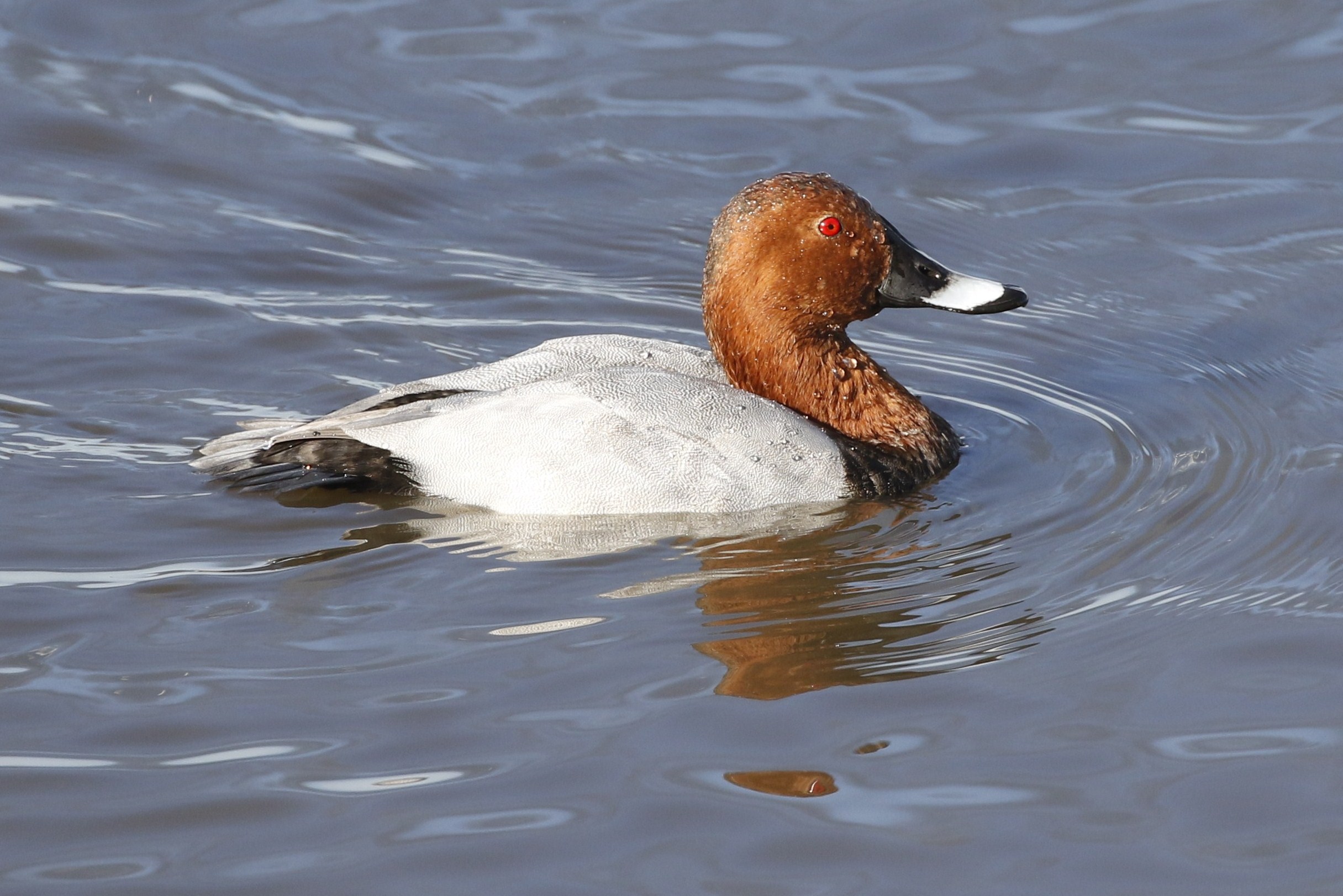
Pochard

Common Shelduck

Greylag Goose

Canada Goose

Bewick’s Swans
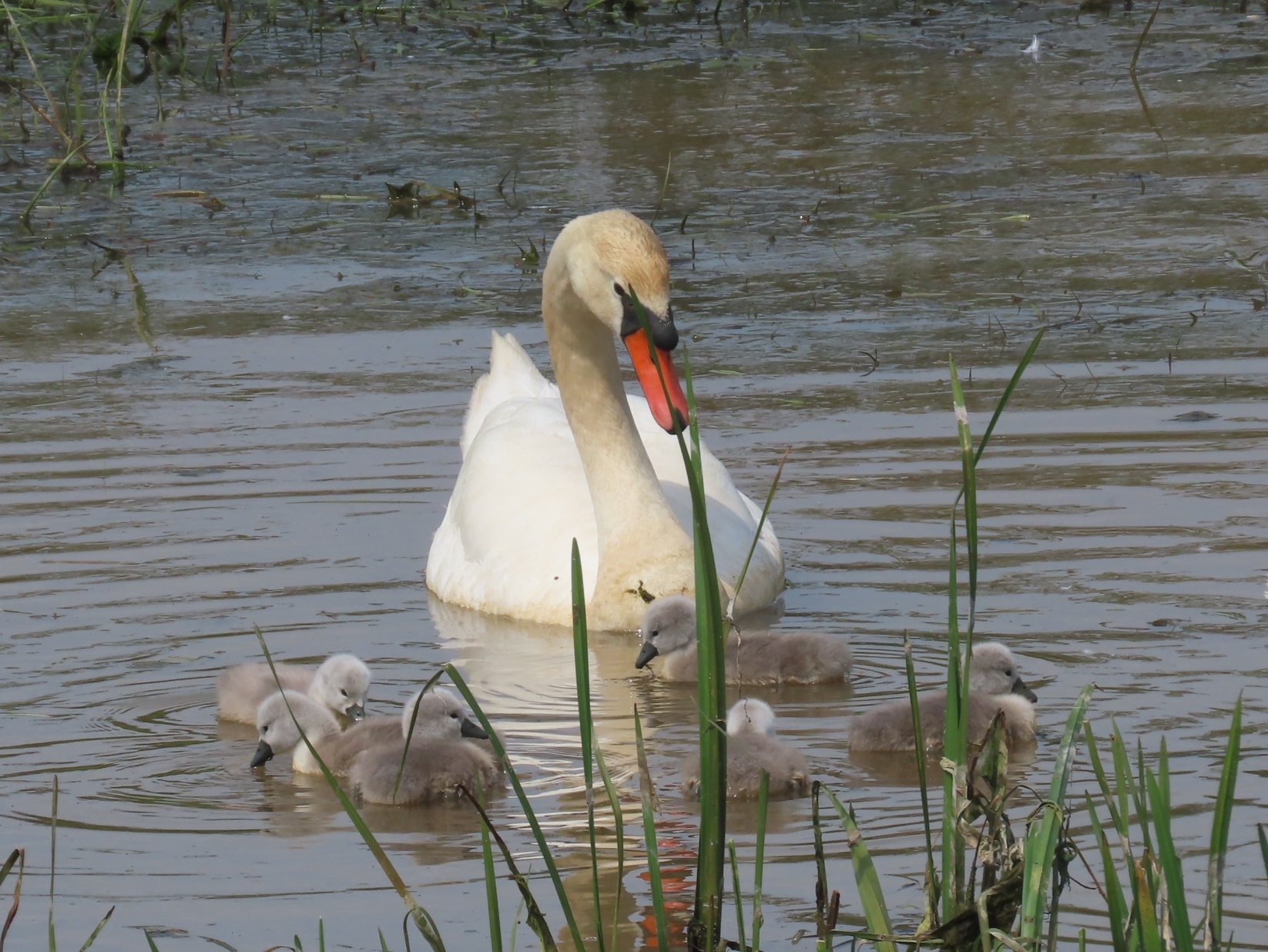
Mute Swan
-

Mallard
Picture by Alison Playle
Our most familiar duck, Mallards can be found on any bodies of water around the parish and numbers do increase during the winter. The male has a bright green head which shines brightly during the sun is out while the female is overall brown colour.
-

Shoveler-Paula
Northern Shoveler
A prominently white duck about the size of a Mallard and like the Mallard it has a bottle-green head that can look black in poor light. It has a long ‘shovel’ like bill which obviously gives this duck its name. The chest is white and merges into brown sides. In flight, it has bright blue wing panels.
-

Teal 5a 31 Oct 2019
Eurasian Teal
Picture by Alison Playle
This is our smallest duck and sometimes during the winter numbers can reach well into the hundreds. The male is a very attractive bird with a chestnut-coloured head that has a thick green stripe while sometimes the green speculum (wing feather) is visible along with a creamy/yellow feather under the wing at the back.
-

Wigeon, Church Norton 19-11-21
Eurasian Wigeon
Picture by Charles Waters
A call that sounds a bit like a referee’s whistle coming from the flooded fields will be coming from this bright colourful duck. In good light, the bright rusty red head with a cream buff stripe down its head, grey body with a white stripe down the side and prominent black and white feathers at the back makes this a very striking bird. In mid-winter when there is plenty of water on the Levels, numbers can reach several hundreds.
-

Gadwall
Gadwall
Picture by Charles Waters
One of the smaller duck species, Gadwall have a much more discreet plumage though if seen close up it is very attractive with beautifully vermiculated plumage. Its overall colour is brown merging into grey and one of the most distinctive features in adult males is a white speculum feather at the back alongside black tail feathers. In flight these white panels are clearly seen.
-

Garganey 10 (1)
Garganey
Picture by Alison Playle
Very occasionally in spring and autumn, the only summer migratory duck to the UK, Garganey, drops in on The Levels often just staying for a few days. It is a similar size to the Teal and is usually quite hard to see as it usually stays within the vegetation. It has a brown-purple head with a prominent white stripe and grey-brown body while the males in flight show a grey-blue patch across the wings.
-

Pintail 11a 8 Mar 2018
Northern Pintail
Picture by Alison Playle
Less numerous in winter than some of the other species, Pintail are another very striking species that has a slim chocolate neck and head with a slim white stripe going up from the neck to the side of the head. It has a white chest merging into grey sides and a long tail that is not always obvious except when it is upending while feeding.
-

Tufted duck Woods Mill
Tufted Duck
When the levels of water are really high it sometimes becomes deep enough to attract diving ducks such as Tufted Ducks. Male Tufted Ducks are strikingly black and white in colour and have a long ‘tuft’ of feathers on its head.
-

Pochard, WWT Welney 2-11-21
Pochard
Picture by Charles Waters
Another diving duck occasionally seen when water levels are high is Pochard, a smallish round grey bodied duck with a chestnut head and black breast and, like Tufted Ducks, dives to feed.
-

Shelduck
Common Shelduck
Shelduck are striking almost goose-like birds that are uncommon but fairly regular on The Levels during the winter. From a distance it looks mainly black and white but has a broad brown band across the chest and seen up more closely, the bright red knob above the beak on the male is visible.
-

Greylag Goose PCB-008
Greylag Goose
The other very common goose we see around is the Greylag Goose, a large plain brown greyish bird with bright orange beak. It breeds on The Levels and in summer the females form large creches of chicks. They are very noisy and the calls sound very much like the Egyptian Goose.
-

Canada Goose - Paula Blake-009
Canada Goose
A very common and increasing species on The Levels is the Canada Goose, a large goose with a long neck leading to a black head and large white patch. It has a grey-brown body and numbers at times reach several hundreds. They fly around the parish in noisy flocks known as skeins.
-

Bewick's Swan
Bewick’s Swans
Sadly, these beautiful swans that once were very regular visitors in winter but not any longer. However, there is a chance that one might turn up occasionally so worth checking all the swans just in case there is one around. Bewick’s Swans are smaller than Mute Swans with yellow and black beaks and are more goose like in appearance.
-

Swan & Cygnets
Mute Swan
A common sight on many water bodies around the parish all year are Mute Swans that do breed in suitable habitats. During the breeding season, they are very territorial but in winter families can join together to form larger flotillas of swans. Large birds with orange beaks make this a very distinctive bird.
Winter Wildfowl
During the winter when the Henfield Levels are in flood, many ducks and geese take advantage of the opportunity of a new habitat suddenly available to them. Many of the ducks migrate down from the north of England and Northern Europe to spend the winter months with us. Here are some of the species to look out for as you view across the flooded fields. The photographs show males as females of most of the duck species all look very similar!















Mallard

Northern Shoveler

Eurasian Teal

Eurasian Wigeon

Gadwall

Garganey

Northern Pintail

Tufted Duck

Pochard

Common Shelduck

Greylag Goose

Canada Goose

Bewick’s Swans

Mute Swan
-

Mallard
Picture by Alison Playle Our most familiar duck, Mallards can be found on any bodies of water around the parish and numbers do increase during the winter. The male has a bright green head which shines brightly during the sun is out while the female is overall brown colour. -

Shoveler-Paula
Northern Shoveler
A prominently white duck about the size of a Mallard and like the Mallard it has a bottle-green head that can look black in poor light. It has a long ‘shovel’ like bill which obviously gives this duck its name. The chest is white and merges into brown sides. In flight, it has bright blue wing panels. -

Teal 5a 31 Oct 2019
Eurasian Teal
Picture by Alison Playle This is our smallest duck and sometimes during the winter numbers can reach well into the hundreds. The male is a very attractive bird with a chestnut-coloured head that has a thick green stripe while sometimes the green speculum (wing feather) is visible along with a creamy/yellow feather under the wing at the back. -

Wigeon, Church Norton 19-11-21
Eurasian Wigeon
Picture by Charles Waters A call that sounds a bit like a referee’s whistle coming from the flooded fields will be coming from this bright colourful duck. In good light, the bright rusty red head with a cream buff stripe down its head, grey body with a white stripe down the side and prominent black and white feathers at the back makes this a very striking bird. In mid-winter when there is plenty of water on the Levels, numbers can reach several hundreds. -

Gadwall
Gadwall
Picture by Charles Waters One of the smaller duck species, Gadwall have a much more discreet plumage though if seen close up it is very attractive with beautifully vermiculated plumage. Its overall colour is brown merging into grey and one of the most distinctive features in adult males is a white speculum feather at the back alongside black tail feathers. In flight these white panels are clearly seen. -

Garganey 10 (1)
Garganey
Picture by Alison Playle Very occasionally in spring and autumn, the only summer migratory duck to the UK, Garganey, drops in on The Levels often just staying for a few days. It is a similar size to the Teal and is usually quite hard to see as it usually stays within the vegetation. It has a brown-purple head with a prominent white stripe and grey-brown body while the males in flight show a grey-blue patch across the wings. -

Pintail 11a 8 Mar 2018
Northern Pintail
Picture by Alison Playle Less numerous in winter than some of the other species, Pintail are another very striking species that has a slim chocolate neck and head with a slim white stripe going up from the neck to the side of the head. It has a white chest merging into grey sides and a long tail that is not always obvious except when it is upending while feeding. -

Tufted duck Woods Mill
Tufted Duck
When the levels of water are really high it sometimes becomes deep enough to attract diving ducks such as Tufted Ducks. Male Tufted Ducks are strikingly black and white in colour and have a long ‘tuft’ of feathers on its head. -

Pochard, WWT Welney 2-11-21
Pochard
Picture by Charles Waters Another diving duck occasionally seen when water levels are high is Pochard, a smallish round grey bodied duck with a chestnut head and black breast and, like Tufted Ducks, dives to feed. -

Shelduck
Common Shelduck
Shelduck are striking almost goose-like birds that are uncommon but fairly regular on The Levels during the winter. From a distance it looks mainly black and white but has a broad brown band across the chest and seen up more closely, the bright red knob above the beak on the male is visible. -

Greylag Goose PCB-008
Greylag Goose
The other very common goose we see around is the Greylag Goose, a large plain brown greyish bird with bright orange beak. It breeds on The Levels and in summer the females form large creches of chicks. They are very noisy and the calls sound very much like the Egyptian Goose. -

Canada Goose - Paula Blake-009
Canada Goose
A very common and increasing species on The Levels is the Canada Goose, a large goose with a long neck leading to a black head and large white patch. It has a grey-brown body and numbers at times reach several hundreds. They fly around the parish in noisy flocks known as skeins. -

Bewick's Swan
Bewick’s Swans
Sadly, these beautiful swans that once were very regular visitors in winter but not any longer. However, there is a chance that one might turn up occasionally so worth checking all the swans just in case there is one around. Bewick’s Swans are smaller than Mute Swans with yellow and black beaks and are more goose like in appearance. -

Swan & Cygnets
Mute Swan
A common sight on many water bodies around the parish all year are Mute Swans that do breed in suitable habitats. During the breeding season, they are very territorial but in winter families can join together to form larger flotillas of swans. Large birds with orange beaks make this a very distinctive bird.
Other birds often visiting gardens

Mallard Ducks

Grey Heron

Wren
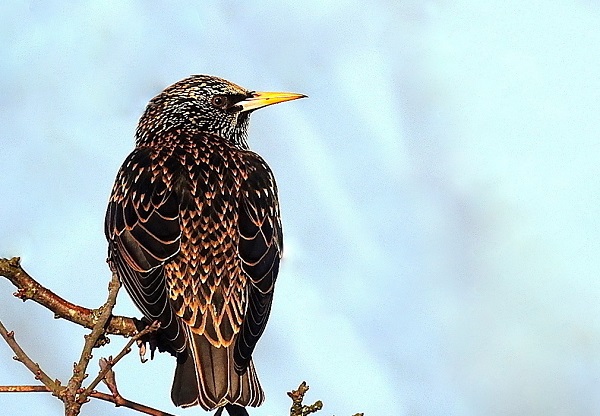
Starling
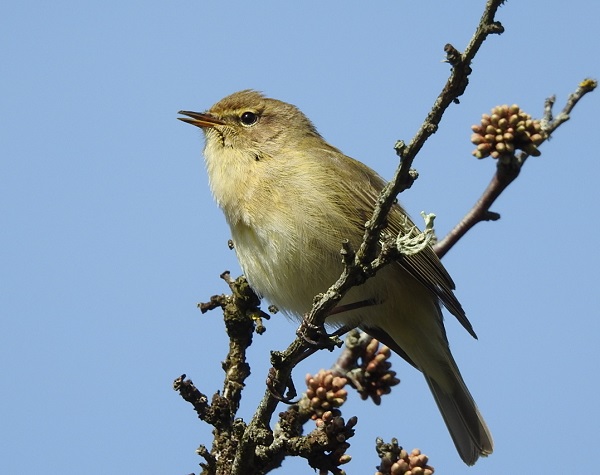
Chiffchaff
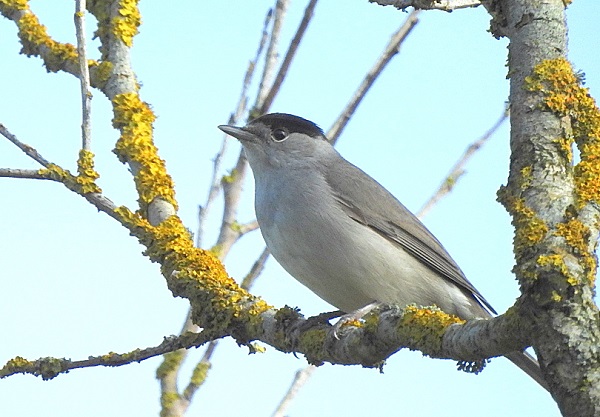
Male Blackcap

Female Blackcap
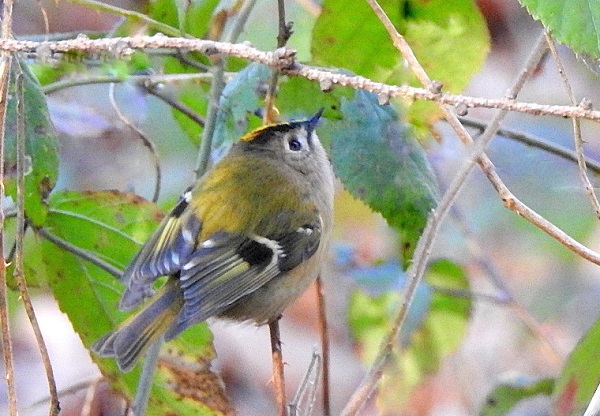
Goldcrest

Nuthatch
-

Mallard Ducks
Mallard Ducks
The only duck you are likely to see in your garden is the Mallard, the most familiar duck to all of us. The male has a bright green head while the female is overall brown colour. Beware of ‘hybrid’ ducks masquerading as Mallards though, as this species has a propensity for mating with a variety of other ducks and geese!
-

Grey Heron
Grey Heron
You need to have a large pond in your garden that’s well stocked with fish to attract a Grey Heron and if you do see one, it is unmistakeable. A large grey bird with a long dagger-like beak for grabbing and stabbing fish, but will also eat frogs and toads and young birds as well.
-

Wren
Wren
A busy, bustling tiny bird that has a song way beyond its size! A very distinctive upright tail, it likes to feed in low vegetation and doesn’t come to bird tables.
Select View More to see a video about them, courtesy of Avibirds.com
-

Starling
Starling
Our most numerous species though declining quite steeply in numbers. This noisy, chattering birder can dominate feeders, they’ll nest under your eaves and during the winter, groups of them will gather on your television aerials before flying off to roost somewhere, probably in Brighton. Young Starlings lack the spangly spots and can look like a young Blackbird.
-

Chiffchaff
Chiffchaff
Another warbler that is now being seen occasionally in winter, a small, delicate olive-green bird, that feeds energetically in trees and bushes.
-

Male Blackcap
Male Blackcap
A member of the warbler family and a summer visitor that is now sometimes seen during the winter. A greyish bird about the size of a sparrow, the male’s cap is black while the female's is brown. Will visit feeders.
-

Blackcap Female - Paula Blake
Female Blackcap
A member of the warbler family and a summer visitor that is now sometimes seen during the winter. A greyish bird about the size of a sparrow, the male’s cap is black while the female's is brown. Will visit feeders.
-

Goldcrest
Goldcrest
Our smallest bird, constantly flitting about picking up tiny insects as it does so, they can be seen in all types of trees and hedgerows but prefers conifers to nest in.
-

Nuthatch
Nuthatch
A striking little bird that tends to fly directly onto a feeder, grab a nut or seed and fly away again. It is a very competent climber and is the only British bird that can move upwards, backwards, sideways and headfirst downwards on tree trunks. They store food in tree crevices to be eaten later.
Other birds often visiting gardens

Mallard Ducks

Grey Heron

Wren

Starling

Chiffchaff

Male Blackcap

Female Blackcap

Goldcrest

Nuthatch
-

Mallard Ducks
Mallard Ducks
The only duck you are likely to see in your garden is the Mallard, the most familiar duck to all of us. The male has a bright green head while the female is overall brown colour. Beware of ‘hybrid’ ducks masquerading as Mallards though, as this species has a propensity for mating with a variety of other ducks and geese! -

Grey Heron
Grey Heron
You need to have a large pond in your garden that’s well stocked with fish to attract a Grey Heron and if you do see one, it is unmistakeable. A large grey bird with a long dagger-like beak for grabbing and stabbing fish, but will also eat frogs and toads and young birds as well. -

Wren
Wren
A busy, bustling tiny bird that has a song way beyond its size! A very distinctive upright tail, it likes to feed in low vegetation and doesn’t come to bird tables. Select View More to see a video about them, courtesy of Avibirds.com -

Starling
Starling
Our most numerous species though declining quite steeply in numbers. This noisy, chattering birder can dominate feeders, they’ll nest under your eaves and during the winter, groups of them will gather on your television aerials before flying off to roost somewhere, probably in Brighton. Young Starlings lack the spangly spots and can look like a young Blackbird. -

Chiffchaff
Chiffchaff
Another warbler that is now being seen occasionally in winter, a small, delicate olive-green bird, that feeds energetically in trees and bushes. -

Male Blackcap
Male Blackcap
A member of the warbler family and a summer visitor that is now sometimes seen during the winter. A greyish bird about the size of a sparrow, the male’s cap is black while the female's is brown. Will visit feeders. -

Blackcap Female - Paula Blake
Female Blackcap
A member of the warbler family and a summer visitor that is now sometimes seen during the winter. A greyish bird about the size of a sparrow, the male’s cap is black while the female's is brown. Will visit feeders. -

Goldcrest
Goldcrest
Our smallest bird, constantly flitting about picking up tiny insects as it does so, they can be seen in all types of trees and hedgerows but prefers conifers to nest in. -

Nuthatch
Nuthatch
A striking little bird that tends to fly directly onto a feeder, grab a nut or seed and fly away again. It is a very competent climber and is the only British bird that can move upwards, backwards, sideways and headfirst downwards on tree trunks. They store food in tree crevices to be eaten later.
Unless stated otherwise, all pictures are copyright to Paula Blake and must not be reproduced without her permission – contact thebirdtable@btinternet.com